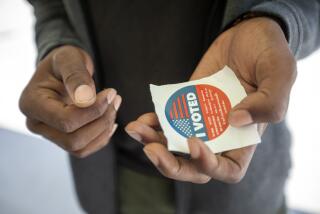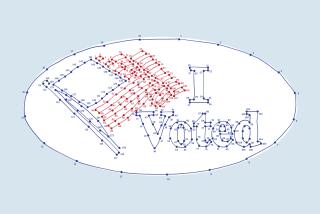Absentee Voting Up Amid Push by Campaigns
- Share via
Spurred in part by vigorous campaigns for governor and against Proposition 226, California voters are applying for absentee ballots in record numbers for a primary election.
Two Democratic gubernatorial candidates as well as unions are running aggressive drives to get people to vote absentee because it gives the campaigns a chance to speak directly to those most likely to cast ballots--and possibly preempt the messages of others.
“It is a very successful tactic,” Sacramento consultant Dave Gilliard said. “There is no better mailing list than a list of actual absentee ballot applicants because you know you are not wasting your money when you talk to them.”
So far, at least 1.9 million voters statewide--more than in any other primary--have applied to vote by mail in Tuesday’s election, according to state officials. Secretary of State Bill Jones has predicted that total voter turnout will be more than 6 million--a record 42% of registered voters.
Absentee voters typically account for about a quarter of the ballots cast statewide, election officials say. Nearly 85% of those who apply for such ballots actually vote, a percentage far higher than the general turnout in even presidential races, they said.
Voting by mail is a growing phenomenon that is shifting the timing of campaigns forward and changing the dynamics of races, political observers and election officials say. If candidates can get the vote out early, they also can avoid the impact of eleventh-hour attacks by opponents.
“No longer can you assume that last-minute attacks will be decisive,” said Sherry Bebitch Jeffe, senior associate at Claremont Graduate University’s school of politics and economics.
“Newspapers and others are endorsing earlier because last-minute endorsements may shut out nearly a quarter of the electorate” that already has voted by mail, she said.
In Los Angeles County, absentee ballots went out to 385,815 voters in the last month. That is 118,000 more than for the gubernatorial primary four years ago and 32,000 more than for the presidential primary two years ago.
“This is a record for a primary,” said Conny McCormack, Los Angeles County’s registrar. “Whether it will translate into a higher turnout is anybody’s guess.”
In order to be counted, absentee ballots must be received by 8 p.m. Tuesday. Those who cannot mail them to the registrar in time can take them to the polls Tuesday and drop them off.
In Orange County, absentee ballots have gone out to nearly 158,000 voters, about 63,000 more than four years ago and only 1,500 shy of the presidential primary two years ago.
“Many counties are reporting absentee ballot requests definitely more along the lines of a presidential primary than a gubernatorial race,” Jones said. “This is a record-setting pace.”
The previous high was in the presidential primary two years ago, when more than 1.5 million voters statewide applied for absentee ballots, Jones said.
Longer Ballot, Convenience Cited
Jones said that another reason for the popularity of absentee voting is the long blanket primary ballot, which lists all candidates together. Some people, he said, like the convenience of voting by mail and want more time to dissect the ballot, which includes nine propositions and far more candidates to consider.
Orange County Registrar of Voters Rosalyn Lever said that every election, more of the electorate is realizing that it is “just a more convenient way” to cast ballots.
Jones said that more attention to absentee voting by the media also has contributed to the increase.
But the biggest factor is the expensive efforts by several candidates and unions to sign up absentee voters, political experts said.
The campaigns of Democrats Jane Harman and Al Checchi for governor have together sent about 4 million absentee ballot applications to voters, election officials said, far more than are usually issued by statewide candidates.
In addition, unions opposing Proposition 226, which would limit the use of union dues in political campaigns, have sent 1 million applications, largely to labor households, said Gale Kaufman, who is running the drive to defeat 226.
Checchi alone sent more than 3 million and got back about 430,000 applications, said Darry Sragow, campaign manager. The campaign has targeted those 430,000 voters, he said, under the assumption they may be leaning toward Checchi.
“They are clearly going to vote and clearly are receptive,” he said. “So it is far more effective and efficient to communicate with this universe than buy TV ads that reach 33 million people, of whom 32.5 million are not going to make the difference in the race.”
The other two Democratic candidates asserted the Checchi mail ballot campaign has been largely futile.
A poll last week by the Gray Davis campaign indicated that voters who received mail ballot applications from Checchi favored Davis more than two to one, said his campaign manager, Gary South.
“We were very clever; we actually had Al Checchi do our absentee ballot campaign for us,” South said, chuckling.
Such poll results shouldn’t be surprising; Checchi is losing in the broader polls. And as absentees make up a greater slice of the electorate, they begin to look more like the rest of the voters, Jeffe pointed out.
Strategy Has Roots in 1978 Rule Change
Local races too are trying to take advantage of the early courting of absentee voters. Consultant Gilliard, for instance, is using the strategy in 10 GOP races around the state, ranging from Assembly candidate Patricia C. Bates in Laguna Niguel to congressional candidate Barbara Alby, an assemblywoman from Sacramento.
Mail-in drives have their roots in a 1978 change in election law that made it easier to vote by mail. The qualifications became pretty much what they are now: If you want to vote absentee, you can. Previously, voters had to meet a strict criteria about disability or absence from the area on election day.
An absentee drive is a distinct effort within the larger campaign, beginning and ending weeks before most voters focus on the contests. It has its own deadlines and mailers.
The first statewide success occurred in 1982 when Republicans seized on a mail-in campaign to boost Atty. Gen. George Deukmejian over Tom Bradley in the gubernatorial race. Deukmejian lost the walk-in vote at the polls, but mail-in ballots gave him a victory by only 93,345 votes.
For years, the absentee vote was seen as the province of Republicans, whose voters included people more likely to be traveling on election day.
These days, though, the strategy is used as effectively by Democrats. Both Harman and Rep. Loretta Sanchez (D-Garden Grove) had trailed at the polls when they first were elected but won with absentee ballots.
Checchi has been the most successful by far in recruiting voters to sign up for mail-in ballots. Harman ran her program in early May, several weeks after Checchi started, and got back applications from 10,000 voters.
“The Checchi thing was huge,” Harman consultant Bill Carrick said. “We mailed later because we wanted to get people as they were thinking about the election.”
The extraordinary aspect about the Checchi effort was the size of its initial solicitation.
Checchi mailed to the state’s most frequent voters, targeting people who had voted in three of the last four major elections, Sragow said. These voters received a multicolored mailer that touted Checchi and contained a vote-by-mail application.
“We were going to mail, so it made sense to include an application,” he said.
Candidates such as Checchi and Harman use absentee voter lists provided by county registrars during the month before the election to target voters by telephone and mail in what is called the chase. Davis “tried to piggy-back” on the unions’ efforts, South said.
“I think a good chase program is just as good, if not better, than sending absentee solicitations, particularly if money is a problem,” said Dick Rosengarten, editor of Calpeek, a weekly newsletter for political insiders.
The Defeat Proposition 226 campaign ran a similar but more directed absentee drive. It was designed to reach people predisposed against 226 and take advantage of the 30 days before the election to get them to vote by mail.
The campaign solicited mainly people who were in union households or groups likely to oppose 226, Kaufman said.
“We know who they are,” she said. “We did follow-up phoning to make sure they had gotten their ballots and turned it back in. It was a very intensive program.”
So far, that effort and the massive advertising blitz of the Defeat 226 campaign have paid off. The proposition, which was well-favored in early polls, has faltered and now appears weak.
More to Read
Get the L.A. Times Politics newsletter
Deeply reported insights into legislation, politics and policy from Sacramento, Washington and beyond. In your inbox three times per week.
You may occasionally receive promotional content from the Los Angeles Times.










